HLSC122 Evidence for Practice: Critical Appraisal of a Research Report
VerifiedAdded on 2023/04/04
|6
|1430
|253
Report
AI Summary
This report presents a critical appraisal of the research paper by Day et al. (2018), which investigates drug use, knowledge, and practices among music festival attendees. The report begins with an introduction to critical appraisal and its importance in evidence-based practice. Part A of the report critically evaluates the research paper's authorship, research questions, design, methods, and results, including its limitations. The analysis highlights the strengths and weaknesses of the study design, sampling methods, and data analysis techniques. Part B focuses on applying the research findings to a case scenario involving a mother's concerns about drug testing at music festivals, and discussing enablers and barriers to the uptake of the research findings in clinical practice. The report concludes by summarizing the key findings and their implications for reducing harm associated with drug use. The report provides a comprehensive overview of the study and its relevance to healthcare practice.
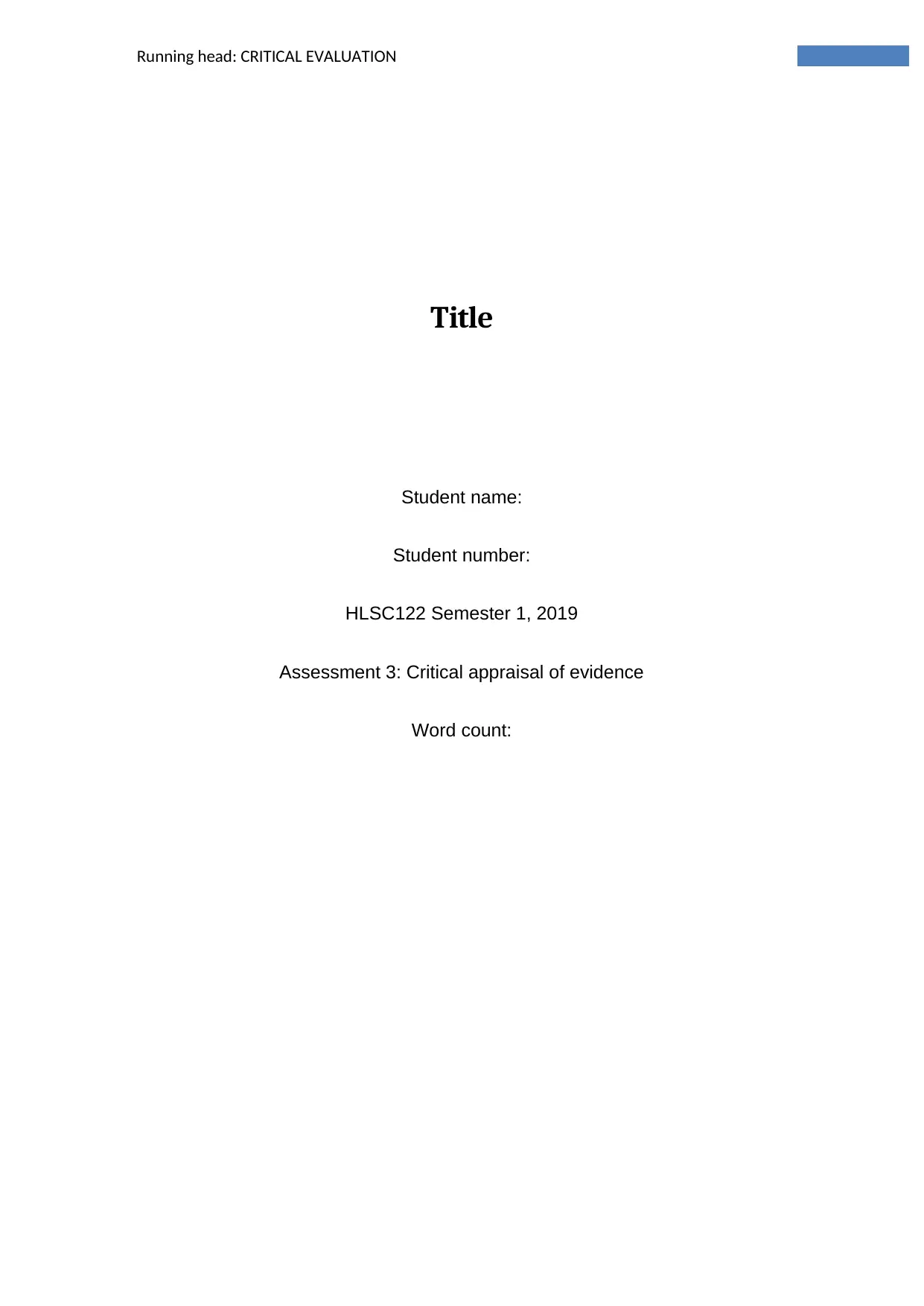
Running head: CRITICAL EVALUATION
Title
Student name:
Student number:
HLSC122 Semester 1, 2019
Assessment 3: Critical appraisal of evidence
Word count:
Title
Student name:
Student number:
HLSC122 Semester 1, 2019
Assessment 3: Critical appraisal of evidence
Word count:
Paraphrase This Document
Need a fresh take? Get an instant paraphrase of this document with our AI Paraphraser
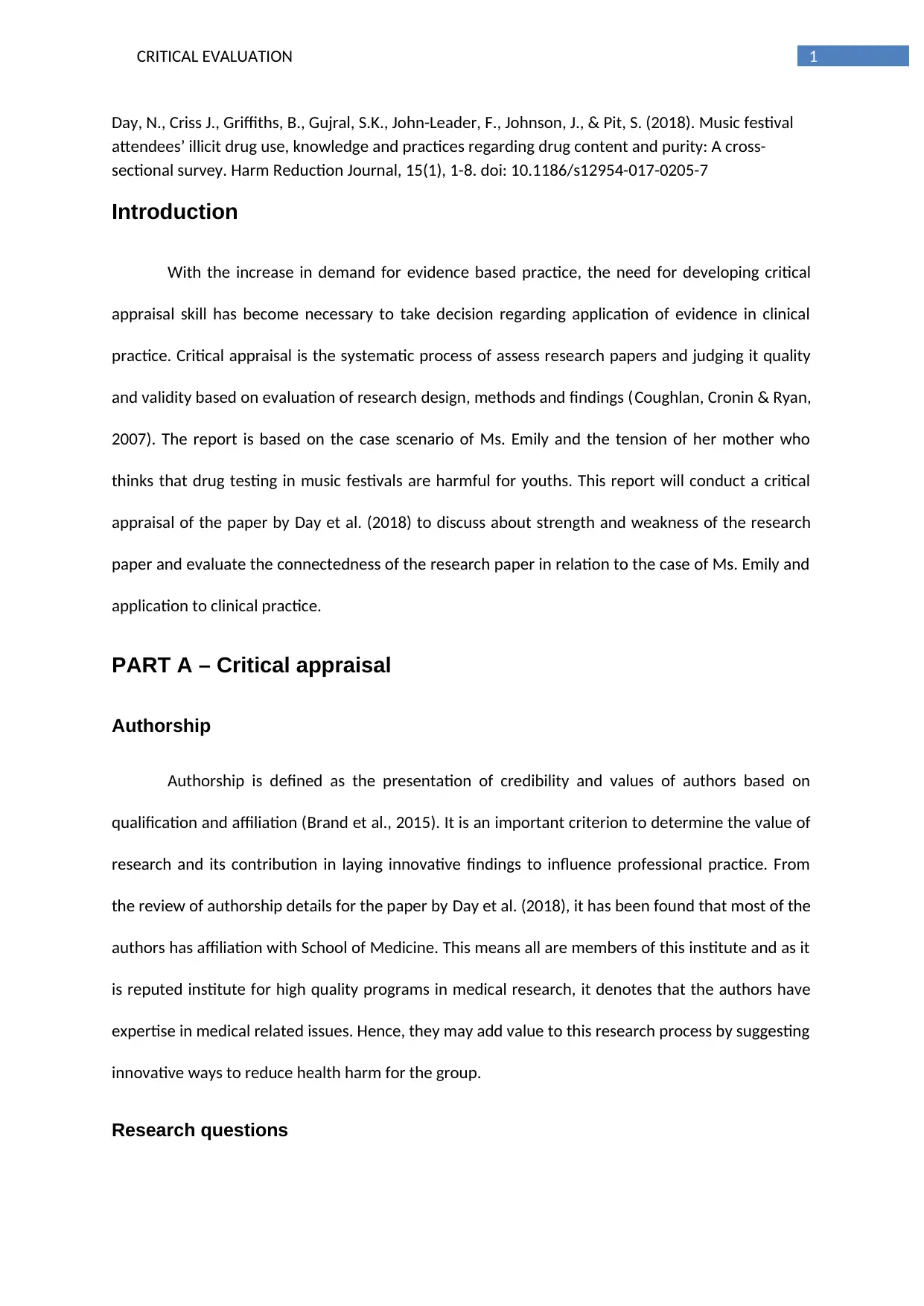
1CRITICAL EVALUATION
Day, N., Criss J., Griffiths, B., Gujral, S.K., John-Leader, F., Johnson, J., & Pit, S. (2018). Music festival
attendees’ illicit drug use, knowledge and practices regarding drug content and purity: A cross-
sectional survey. Harm Reduction Journal, 15(1), 1-8. doi: 10.1186/s12954-017-0205-7
Introduction
With the increase in demand for evidence based practice, the need for developing critical
appraisal skill has become necessary to take decision regarding application of evidence in clinical
practice. Critical appraisal is the systematic process of assess research papers and judging it quality
and validity based on evaluation of research design, methods and findings (Coughlan, Cronin & Ryan,
2007). The report is based on the case scenario of Ms. Emily and the tension of her mother who
thinks that drug testing in music festivals are harmful for youths. This report will conduct a critical
appraisal of the paper by Day et al. (2018) to discuss about strength and weakness of the research
paper and evaluate the connectedness of the research paper in relation to the case of Ms. Emily and
application to clinical practice.
PART A – Critical appraisal
Authorship
Authorship is defined as the presentation of credibility and values of authors based on
qualification and affiliation (Brand et al., 2015). It is an important criterion to determine the value of
research and its contribution in laying innovative findings to influence professional practice. From
the review of authorship details for the paper by Day et al. (2018), it has been found that most of the
authors has affiliation with School of Medicine. This means all are members of this institute and as it
is reputed institute for high quality programs in medical research, it denotes that the authors have
expertise in medical related issues. Hence, they may add value to this research process by suggesting
innovative ways to reduce health harm for the group.
Research questions
Day, N., Criss J., Griffiths, B., Gujral, S.K., John-Leader, F., Johnson, J., & Pit, S. (2018). Music festival
attendees’ illicit drug use, knowledge and practices regarding drug content and purity: A cross-
sectional survey. Harm Reduction Journal, 15(1), 1-8. doi: 10.1186/s12954-017-0205-7
Introduction
With the increase in demand for evidence based practice, the need for developing critical
appraisal skill has become necessary to take decision regarding application of evidence in clinical
practice. Critical appraisal is the systematic process of assess research papers and judging it quality
and validity based on evaluation of research design, methods and findings (Coughlan, Cronin & Ryan,
2007). The report is based on the case scenario of Ms. Emily and the tension of her mother who
thinks that drug testing in music festivals are harmful for youths. This report will conduct a critical
appraisal of the paper by Day et al. (2018) to discuss about strength and weakness of the research
paper and evaluate the connectedness of the research paper in relation to the case of Ms. Emily and
application to clinical practice.
PART A – Critical appraisal
Authorship
Authorship is defined as the presentation of credibility and values of authors based on
qualification and affiliation (Brand et al., 2015). It is an important criterion to determine the value of
research and its contribution in laying innovative findings to influence professional practice. From
the review of authorship details for the paper by Day et al. (2018), it has been found that most of the
authors has affiliation with School of Medicine. This means all are members of this institute and as it
is reputed institute for high quality programs in medical research, it denotes that the authors have
expertise in medical related issues. Hence, they may add value to this research process by suggesting
innovative ways to reduce health harm for the group.
Research questions
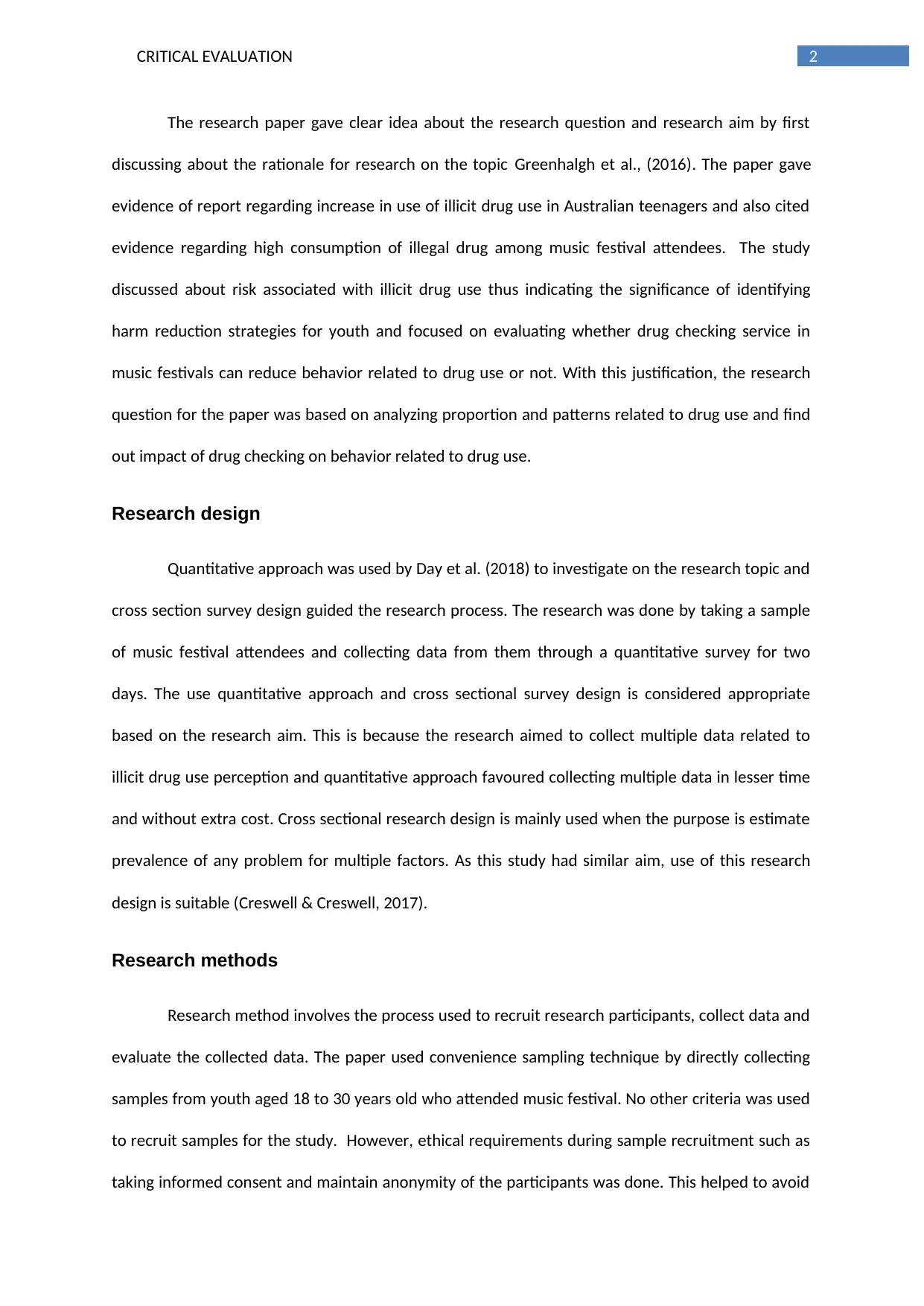
2CRITICAL EVALUATION
The research paper gave clear idea about the research question and research aim by first
discussing about the rationale for research on the topic Greenhalgh et al., (2016). The paper gave
evidence of report regarding increase in use of illicit drug use in Australian teenagers and also cited
evidence regarding high consumption of illegal drug among music festival attendees. The study
discussed about risk associated with illicit drug use thus indicating the significance of identifying
harm reduction strategies for youth and focused on evaluating whether drug checking service in
music festivals can reduce behavior related to drug use or not. With this justification, the research
question for the paper was based on analyzing proportion and patterns related to drug use and find
out impact of drug checking on behavior related to drug use.
Research design
Quantitative approach was used by Day et al. (2018) to investigate on the research topic and
cross section survey design guided the research process. The research was done by taking a sample
of music festival attendees and collecting data from them through a quantitative survey for two
days. The use quantitative approach and cross sectional survey design is considered appropriate
based on the research aim. This is because the research aimed to collect multiple data related to
illicit drug use perception and quantitative approach favoured collecting multiple data in lesser time
and without extra cost. Cross sectional research design is mainly used when the purpose is estimate
prevalence of any problem for multiple factors. As this study had similar aim, use of this research
design is suitable (Creswell & Creswell, 2017).
Research methods
Research method involves the process used to recruit research participants, collect data and
evaluate the collected data. The paper used convenience sampling technique by directly collecting
samples from youth aged 18 to 30 years old who attended music festival. No other criteria was used
to recruit samples for the study. However, ethical requirements during sample recruitment such as
taking informed consent and maintain anonymity of the participants was done. This helped to avoid
The research paper gave clear idea about the research question and research aim by first
discussing about the rationale for research on the topic Greenhalgh et al., (2016). The paper gave
evidence of report regarding increase in use of illicit drug use in Australian teenagers and also cited
evidence regarding high consumption of illegal drug among music festival attendees. The study
discussed about risk associated with illicit drug use thus indicating the significance of identifying
harm reduction strategies for youth and focused on evaluating whether drug checking service in
music festivals can reduce behavior related to drug use or not. With this justification, the research
question for the paper was based on analyzing proportion and patterns related to drug use and find
out impact of drug checking on behavior related to drug use.
Research design
Quantitative approach was used by Day et al. (2018) to investigate on the research topic and
cross section survey design guided the research process. The research was done by taking a sample
of music festival attendees and collecting data from them through a quantitative survey for two
days. The use quantitative approach and cross sectional survey design is considered appropriate
based on the research aim. This is because the research aimed to collect multiple data related to
illicit drug use perception and quantitative approach favoured collecting multiple data in lesser time
and without extra cost. Cross sectional research design is mainly used when the purpose is estimate
prevalence of any problem for multiple factors. As this study had similar aim, use of this research
design is suitable (Creswell & Creswell, 2017).
Research methods
Research method involves the process used to recruit research participants, collect data and
evaluate the collected data. The paper used convenience sampling technique by directly collecting
samples from youth aged 18 to 30 years old who attended music festival. No other criteria was used
to recruit samples for the study. However, ethical requirements during sample recruitment such as
taking informed consent and maintain anonymity of the participants was done. This helped to avoid
⊘ This is a preview!⊘
Do you want full access?
Subscribe today to unlock all pages.

Trusted by 1+ million students worldwide
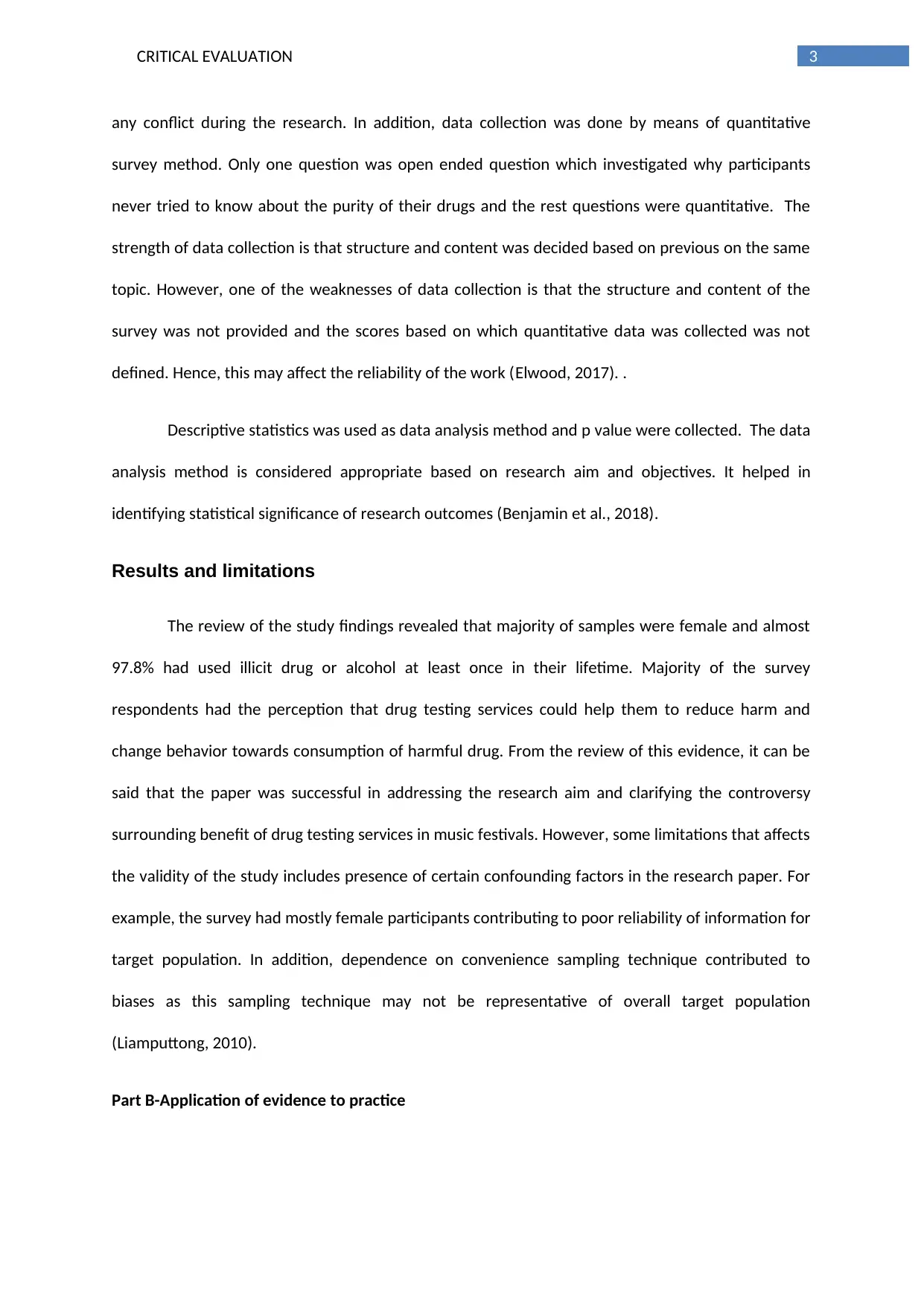
3CRITICAL EVALUATION
any conflict during the research. In addition, data collection was done by means of quantitative
survey method. Only one question was open ended question which investigated why participants
never tried to know about the purity of their drugs and the rest questions were quantitative. The
strength of data collection is that structure and content was decided based on previous on the same
topic. However, one of the weaknesses of data collection is that the structure and content of the
survey was not provided and the scores based on which quantitative data was collected was not
defined. Hence, this may affect the reliability of the work (Elwood, 2017). .
Descriptive statistics was used as data analysis method and p value were collected. The data
analysis method is considered appropriate based on research aim and objectives. It helped in
identifying statistical significance of research outcomes (Benjamin et al., 2018).
Results and limitations
The review of the study findings revealed that majority of samples were female and almost
97.8% had used illicit drug or alcohol at least once in their lifetime. Majority of the survey
respondents had the perception that drug testing services could help them to reduce harm and
change behavior towards consumption of harmful drug. From the review of this evidence, it can be
said that the paper was successful in addressing the research aim and clarifying the controversy
surrounding benefit of drug testing services in music festivals. However, some limitations that affects
the validity of the study includes presence of certain confounding factors in the research paper. For
example, the survey had mostly female participants contributing to poor reliability of information for
target population. In addition, dependence on convenience sampling technique contributed to
biases as this sampling technique may not be representative of overall target population
(Liamputtong, 2010).
Part B-Application of evidence to practice
any conflict during the research. In addition, data collection was done by means of quantitative
survey method. Only one question was open ended question which investigated why participants
never tried to know about the purity of their drugs and the rest questions were quantitative. The
strength of data collection is that structure and content was decided based on previous on the same
topic. However, one of the weaknesses of data collection is that the structure and content of the
survey was not provided and the scores based on which quantitative data was collected was not
defined. Hence, this may affect the reliability of the work (Elwood, 2017). .
Descriptive statistics was used as data analysis method and p value were collected. The data
analysis method is considered appropriate based on research aim and objectives. It helped in
identifying statistical significance of research outcomes (Benjamin et al., 2018).
Results and limitations
The review of the study findings revealed that majority of samples were female and almost
97.8% had used illicit drug or alcohol at least once in their lifetime. Majority of the survey
respondents had the perception that drug testing services could help them to reduce harm and
change behavior towards consumption of harmful drug. From the review of this evidence, it can be
said that the paper was successful in addressing the research aim and clarifying the controversy
surrounding benefit of drug testing services in music festivals. However, some limitations that affects
the validity of the study includes presence of certain confounding factors in the research paper. For
example, the survey had mostly female participants contributing to poor reliability of information for
target population. In addition, dependence on convenience sampling technique contributed to
biases as this sampling technique may not be representative of overall target population
(Liamputtong, 2010).
Part B-Application of evidence to practice
Paraphrase This Document
Need a fresh take? Get an instant paraphrase of this document with our AI Paraphraser
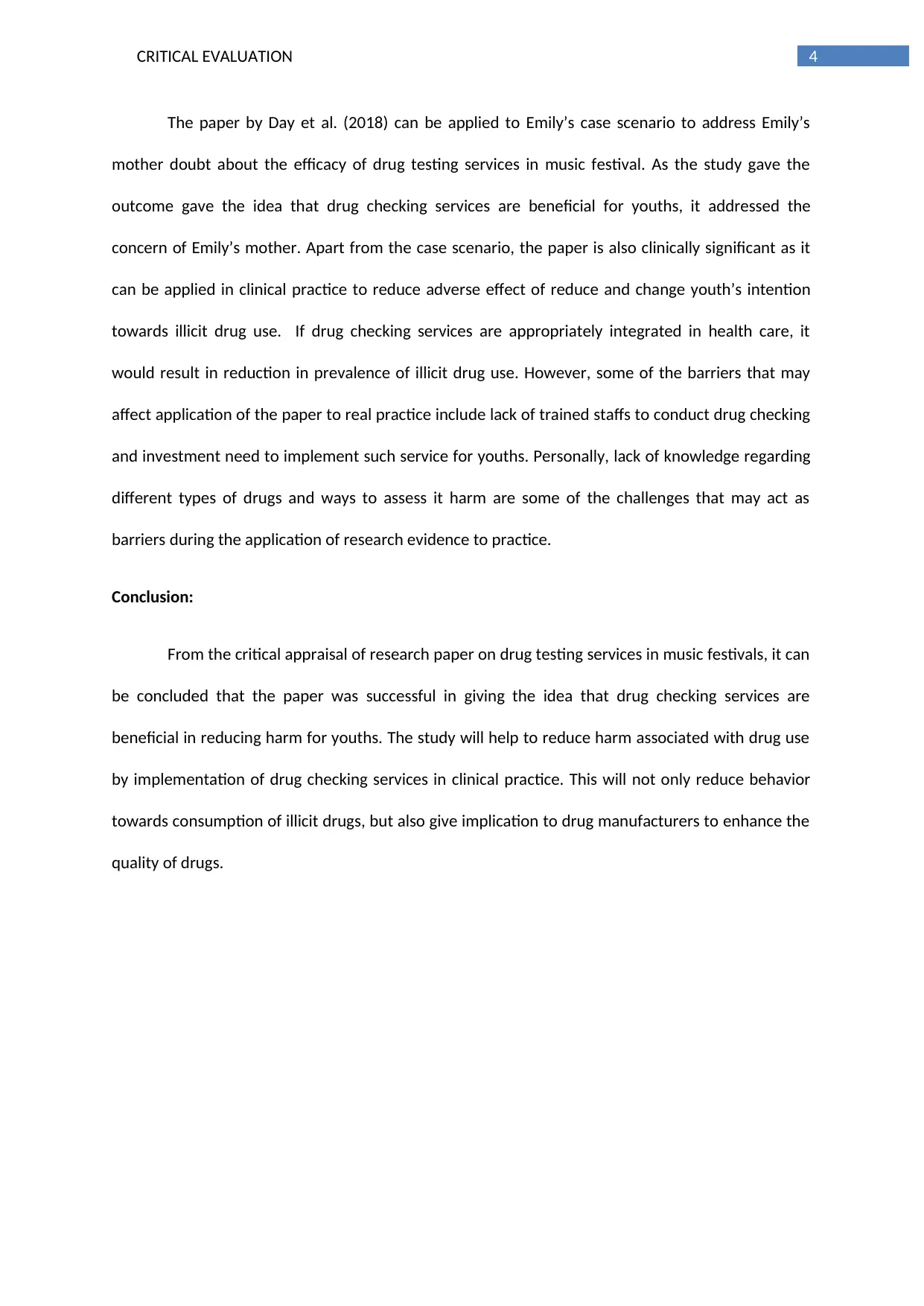
4CRITICAL EVALUATION
The paper by Day et al. (2018) can be applied to Emily’s case scenario to address Emily’s
mother doubt about the efficacy of drug testing services in music festival. As the study gave the
outcome gave the idea that drug checking services are beneficial for youths, it addressed the
concern of Emily’s mother. Apart from the case scenario, the paper is also clinically significant as it
can be applied in clinical practice to reduce adverse effect of reduce and change youth’s intention
towards illicit drug use. If drug checking services are appropriately integrated in health care, it
would result in reduction in prevalence of illicit drug use. However, some of the barriers that may
affect application of the paper to real practice include lack of trained staffs to conduct drug checking
and investment need to implement such service for youths. Personally, lack of knowledge regarding
different types of drugs and ways to assess it harm are some of the challenges that may act as
barriers during the application of research evidence to practice.
Conclusion:
From the critical appraisal of research paper on drug testing services in music festivals, it can
be concluded that the paper was successful in giving the idea that drug checking services are
beneficial in reducing harm for youths. The study will help to reduce harm associated with drug use
by implementation of drug checking services in clinical practice. This will not only reduce behavior
towards consumption of illicit drugs, but also give implication to drug manufacturers to enhance the
quality of drugs.
The paper by Day et al. (2018) can be applied to Emily’s case scenario to address Emily’s
mother doubt about the efficacy of drug testing services in music festival. As the study gave the
outcome gave the idea that drug checking services are beneficial for youths, it addressed the
concern of Emily’s mother. Apart from the case scenario, the paper is also clinically significant as it
can be applied in clinical practice to reduce adverse effect of reduce and change youth’s intention
towards illicit drug use. If drug checking services are appropriately integrated in health care, it
would result in reduction in prevalence of illicit drug use. However, some of the barriers that may
affect application of the paper to real practice include lack of trained staffs to conduct drug checking
and investment need to implement such service for youths. Personally, lack of knowledge regarding
different types of drugs and ways to assess it harm are some of the challenges that may act as
barriers during the application of research evidence to practice.
Conclusion:
From the critical appraisal of research paper on drug testing services in music festivals, it can
be concluded that the paper was successful in giving the idea that drug checking services are
beneficial in reducing harm for youths. The study will help to reduce harm associated with drug use
by implementation of drug checking services in clinical practice. This will not only reduce behavior
towards consumption of illicit drugs, but also give implication to drug manufacturers to enhance the
quality of drugs.
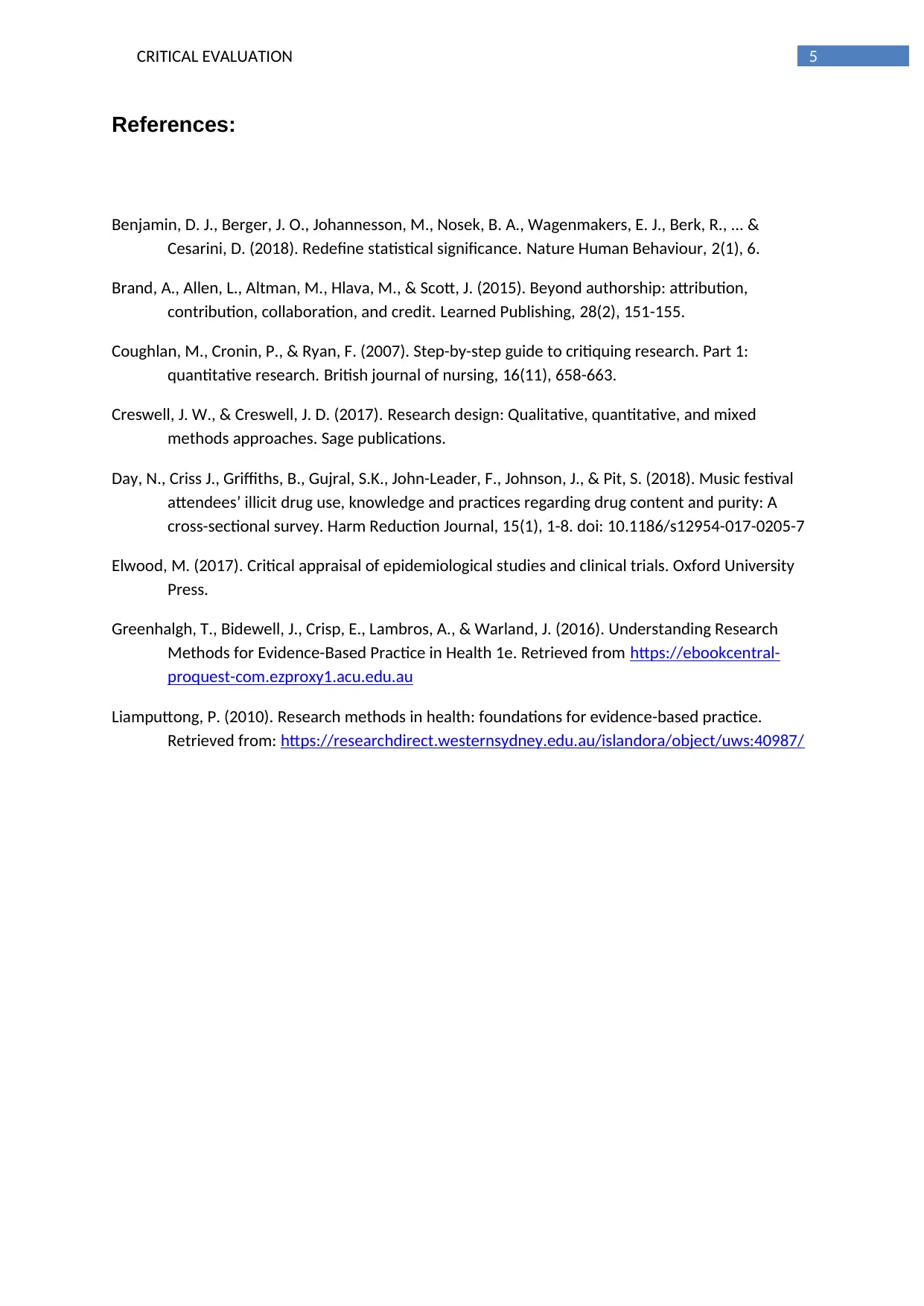
5CRITICAL EVALUATION
References:
Benjamin, D. J., Berger, J. O., Johannesson, M., Nosek, B. A., Wagenmakers, E. J., Berk, R., ... &
Cesarini, D. (2018). Redefine statistical significance. Nature Human Behaviour, 2(1), 6.
Brand, A., Allen, L., Altman, M., Hlava, M., & Scott, J. (2015). Beyond authorship: attribution,
contribution, collaboration, and credit. Learned Publishing, 28(2), 151-155.
Coughlan, M., Cronin, P., & Ryan, F. (2007). Step-by-step guide to critiquing research. Part 1:
quantitative research. British journal of nursing, 16(11), 658-663.
Creswell, J. W., & Creswell, J. D. (2017). Research design: Qualitative, quantitative, and mixed
methods approaches. Sage publications.
Day, N., Criss J., Griffiths, B., Gujral, S.K., John-Leader, F., Johnson, J., & Pit, S. (2018). Music festival
attendees’ illicit drug use, knowledge and practices regarding drug content and purity: A
cross-sectional survey. Harm Reduction Journal, 15(1), 1-8. doi: 10.1186/s12954-017-0205-7
Elwood, M. (2017). Critical appraisal of epidemiological studies and clinical trials. Oxford University
Press.
Greenhalgh, T., Bidewell, J., Crisp, E., Lambros, A., & Warland, J. (2016). Understanding Research
Methods for Evidence-Based Practice in Health 1e. Retrieved from https://ebookcentral-
proquest-com.ezproxy1.acu.edu.au
Liamputtong, P. (2010). Research methods in health: foundations for evidence-based practice.
Retrieved from: https://researchdirect.westernsydney.edu.au/islandora/object/uws:40987/
References:
Benjamin, D. J., Berger, J. O., Johannesson, M., Nosek, B. A., Wagenmakers, E. J., Berk, R., ... &
Cesarini, D. (2018). Redefine statistical significance. Nature Human Behaviour, 2(1), 6.
Brand, A., Allen, L., Altman, M., Hlava, M., & Scott, J. (2015). Beyond authorship: attribution,
contribution, collaboration, and credit. Learned Publishing, 28(2), 151-155.
Coughlan, M., Cronin, P., & Ryan, F. (2007). Step-by-step guide to critiquing research. Part 1:
quantitative research. British journal of nursing, 16(11), 658-663.
Creswell, J. W., & Creswell, J. D. (2017). Research design: Qualitative, quantitative, and mixed
methods approaches. Sage publications.
Day, N., Criss J., Griffiths, B., Gujral, S.K., John-Leader, F., Johnson, J., & Pit, S. (2018). Music festival
attendees’ illicit drug use, knowledge and practices regarding drug content and purity: A
cross-sectional survey. Harm Reduction Journal, 15(1), 1-8. doi: 10.1186/s12954-017-0205-7
Elwood, M. (2017). Critical appraisal of epidemiological studies and clinical trials. Oxford University
Press.
Greenhalgh, T., Bidewell, J., Crisp, E., Lambros, A., & Warland, J. (2016). Understanding Research
Methods for Evidence-Based Practice in Health 1e. Retrieved from https://ebookcentral-
proquest-com.ezproxy1.acu.edu.au
Liamputtong, P. (2010). Research methods in health: foundations for evidence-based practice.
Retrieved from: https://researchdirect.westernsydney.edu.au/islandora/object/uws:40987/
⊘ This is a preview!⊘
Do you want full access?
Subscribe today to unlock all pages.

Trusted by 1+ million students worldwide
1 out of 6
Related Documents
Your All-in-One AI-Powered Toolkit for Academic Success.
+13062052269
info@desklib.com
Available 24*7 on WhatsApp / Email
![[object Object]](/_next/static/media/star-bottom.7253800d.svg)
Unlock your academic potential
Copyright © 2020–2025 A2Z Services. All Rights Reserved. Developed and managed by ZUCOL.





